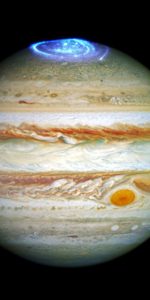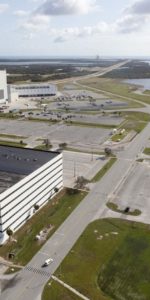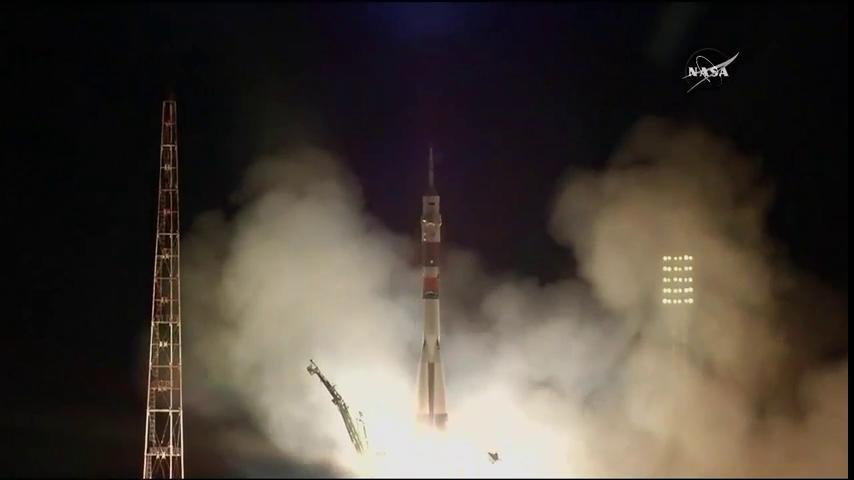
Three new crew members are en-route to the International Space Station (ISS), following an on-time launch of Soyuz MS-06 from the Baikonur Cosmodrome in Kazakhstan. Liftoff of Russian cosmonaut Aleksandr Misurkin and his U.S. crewmates Mark Vande Hei and Joe Acaba occurred at 3:17 a.m. local time Wednesday (5:17 p.m. EDT Tuesday) and at the time of writing the trio are following a six-hour and four-orbit “fast rendezvous”, with the expectation that they will dock at the station’s space-facing (or “zenith”) Poisk module at 10:57 p.m. EDT. Misurkin, Vande Hei and Acaba will form the second half of the incumbent Expedition 53, commanded by veteran NASA astronaut Randy Bresnik. When Expedition 53 returns to Earth in mid-December, Misurkin will assume command of Expedition 54, through late February 2018.
As previously outlined by AmericaSpace, this crewing composition has changed substantially in recent months. Original plans anticipated Misurkin, Vande Hei and cosmonaut Nikolai Tikhonov to launch on Soyuz MS-04 in March 2017. However, Russia’s decision last year to reduce its crew complement aboard the ISS led to the elimination of Tikhonov and the retraining of Vande Hei to assume his former duty in the systems-intensive Flight Engineer-1 seat aboard the Soyuz. To allow for Vande Hei’s additional training, his mission with Misurkin was correspondingly moved to the Soyuz MS-06 slot in September 2017. In tandem, NASA took advantage of the reduction of Russian cosmonauts and added an extra U.S. astronaut to the station’s crew, thereby ensuring a permanent six-strong staff.
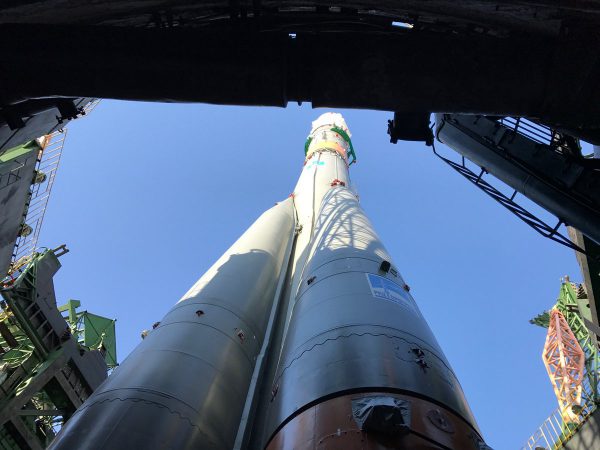
That extra astronaut was veteran shuttle and ISS resident Joe Acaba, who was selected back in May 2004 as a NASA “educator-astronaut”. And when fellow educator-astronaut Ricky Arnold flies as a member of the Soyuz MS-08 crew in March 2018, the situation will uniquely see a pair of (ex) teachers aboard the ISS for almost an entire academic year. For Acaba—who previously served as head of the astronaut office’s ISS Operations Branch—it has given him the shortest training template of any long-duration ISS crew member. Named to the crew in March 2017, his schedule has been compressed into just six months, which is roughly the same length of time that Acaba will be in orbit.
Speaking earlier this year to AmericaSpace’s Michael Galindo, he explained that his branch chief post “kept me current in ISS operations”, as well as “on different types of training”, but also stressed that having been through a full training flow on a previous occasion was beneficial. That said, Vande Hei has been in training for this mission since 2015 and has long since attained “specialist” level in U.S. Orbital Segment (USOS) systems. This allowed the two astronauts to divide up their responsibilities and permitted Acaba to fit the requisite preparations into his greatly abbreviated training flow. In his recent Twitter posts, he has outlined Extravehicular Activity (EVA) skills training in July, refresher activity on the European Columbus lab systems in August and a final emergency scenarios training session a few weeks ago.
Acaba has not fulfilled a backup crew duty for this increment, but by contrast Misurkin and Vande Hei have stood in reserve for no fewer than two ISS-bound expeditions in recent months. The duo, together with Tikhonov, were at Baikonur last October, in support of Soyuz MS-02, when their new mission began to take shape, and more recently—teamed with Japanese astronaut Norishige Kanai—they backed-up Soyuz MS-05. Last week, after a farewell breakfast at the Star City cosmonauts’ training center, near Moscow, Acaba tweeted that his crew and their backups were in place at Baikonur. Rollout of the 162.4-foot-tall (49.5-meter) Soyuz-FG rocket from the assembly building to the launch pad occurred on 10 September, prompting Vande Hei to tweet an unusual perspective of his brother-in-law’s hands forming a heart-like shape around the crew module. It has become traditional that the prime crew should not see their vehicle during rollout and, as such, backup astronaut Scott Tingle witnessed the slow transfer of the Soyuz-FG to the pad. “There it is!” tweeted Tingle, using the respective Twitter handles for Vande Hei and Acaba . “The Soyuz MS-06 rocket on the launch pad, ready to bring my friends Sasha, @Astro_Sabot and @AstroAcaba to @Space_Station.”
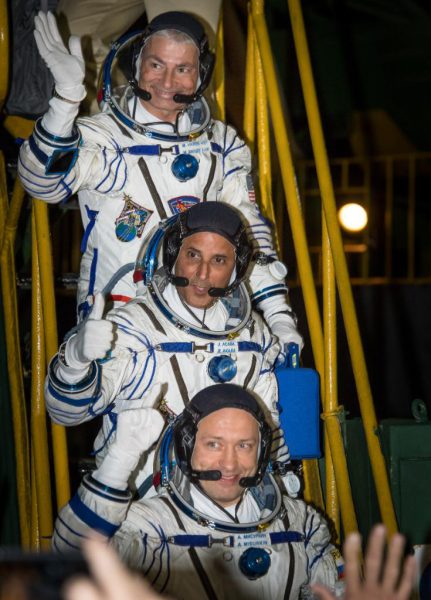
Prime and backup crews for Soyuz MS-06 were awakened about 8.5 hours before launch, although Vande Hei arose earlier. “Launch-9 hours,” he tweeted shortly after 6 p.m. local time (8 a.m. EDT) Tuesday. “The pre-launch nap time is ending shortly. In the meantime, those of us that are already awake are whispering quietly.” After showering and dressing, they ceremonially autographed their hotel room doors and received a customary blessing from a Russian Orthodox priest, before processing to Baikonur’s Site 254 for suiting-up in their Sokol (“Falcon”) launch and entry suits. This presented Misurkin, Vande Hei and Acaba with a final opportunity—albeit from behind glass screens—to bid farewell to their families, friends and co-workers. The three men were then bussed out to Site 1/5, where their giant rocket awaited their presence. Misurkin, making his second space mission, was inserted into the center commander’s seat aboard Soyuz MS-06, flanked by Vande Hei to his left as Flight Engineer-1 and Acaba to his right as Flight Engineer-2.
In the final hour, as many eyes focused on Baikonur, so too did the eyes of Paolo Nespoli, currently aboard the space station. “Enjoy the trip,” he tweeted in Italian. “See you across the door.”
With characteristic smoothness, final operations to load propellants aboard the Soyuz-FG proceeded like clockwork. Five minutes before T-0, Misurkin’s controls were activated and the crew were ordered to close their space suit visors for launch. From within the control bunker, the “launch key” was inserted to enable the ordnance and at T-10 seconds the turbopumps of the rocket’s RD-108 first-stage engine and the RD-107 engines of its four tapering strap-on boosters attained full speed. Five seconds later, the engines ignited and ramped up to maximum power, producing a liftoff at 3:17 a.m. local time Wednesday, 13 September (5:17 p.m. EDT Tuesday, 12 September).
The vehicle produced an estimated 930,000 pounds (422,000 kg) of thrust at liftoff, with the strap-on boosters discarded about two minutes into the flight. This left the core alone to power Misurkin, Vande Hei and Acaba through 1,100 mph (1,770 km/h). Finally, the RD-108 burned out a little under five minutes into the mission, by which time Soyuz MS-06 had reached an altitude of 105.6 miles (170 km). The rocket’s third stage then burned its RD-0110 engine to push the spacecraft to a velocity in excess of 13,420 mph (21,600 km/h). Shutting down nine minutes after launch, the Soyuz-FG left the three men in a preliminary orbit with an apogee of 143 miles (230 km) and a perigee of 118 miles (190 km), inclined 51.66 degrees to the equator.
It has long been traditional for Soyuz crews to carry a “gravity indicator”, whose transition from hanging on a string to floating provides the first indication of weightlessness. On past occasions, astronauts and cosmonauts have flown toys from their children, but Soyuz MS-06 did something rather special. In three weeks’ time, the world will observe 60 years since the Soviet Union launched Sputnik 1 and inaugurated the Space Age. Hanging in the Soyuz MS-06 cabin was a small model of the spherical satellite which spent three months in space between 4 October 1957 and its re-entry on 4 January 1958.
The next few hours were expected to involve the deployment of Soyuz MS-06’s electricity-generating solar arrays and its communications and navigation appendages, together with a series of Delta-Velocity (DV) “burns” to align them with the space station. According to the timeline, Misurkin will dock at the Poisk module at 10:57 p.m. EDT, just five hours and 30 minutes into the flight.
Upon arrival at the station, Misurkin, Vande Hei and Acaba will join Expedition 53 Commander Randy Bresnik—who recently became the first U.S. Marine Corps officer to command the ISS—and his crewmates Sergei Ryazansky of Russia and seasoned Italian astronaut Paolo Nespoli. This trio have been aboard the space station since late July. The six men will work together as a crew for three months, before Bresnik, Ryazansky and Nespoli return to Earth aboard their Soyuz MS-05 spacecraft on 14 December, whereupon Misurkin will take the helm as Commander of Expedition 54. His crew will be restored to six-man strength a few days later, when Soyuz MS-07 brings veteran Russian cosmonaut Anton Shkaplerov, U.S. astronaut Scott Tingle and Japan’s Norishige Kanai. Current plans call for Soyuz MS-07 to fly out of Baikonur on 17 December, ten days sooner than originally timetabled, in order to avoid conducting launch and docking operations over Christmas. It remains to be seen if the spacecraft will execute a fast rendezvous or a longer, two-day flight profile to reach the ISS. That decision will be made after detailed ballistics analysis.
Misurkin, Vande Hei and Acaba will spend 168 days in space, with landing of Soyuz MS-06 currently targeted for 27 February. During their increment across Expeditions 53 and 54, they are expected to welcome two Russian Progress cargo ships in October and February, Orbital ATK’s OA-8 Cygnus in November, a pair of SpaceX Dragons in December and January and perhaps Japan’s HTV-7 Kounotori (“White Stork”) in February. Additionally, as many as three U.S. EVAs are planned in the October-November timeframe, plus at least one Russian spacewalk by Misurkin and Shkaplerov in January.
Be sure to “LIKE” AmericaSpace on Facebook and follow us on Instagram & Twitter!




